10 Plants With Red Stems
Have you found unknown plants with red stems and need help identifying them? See this list of 10 plants that have reddish stems that stand out.
Whether you are passionate about nature or have just come across unknown plants that grow on your property or in the wild, you may want to find out what those plants are. Knowing how to recognize a plant correctly may sometimes be vital, especially in a survival situation when you have to identify a plant to know if its fruits are edible or poisonous.
Some plants are easier to classify than others due to their distinct characteristics. Others are much harder to distinguish and can easily be confused with other similar species.
In the case of plants with a red stem, you already have an advantage as this is an obvious particularity.
We made a list of 10 plants that have full or partial red stems in at least a stage of their growth. Hopefully, it will help you and other people to identify the unknown plants that show these characteristics.
Contents
- 1. Pokeweed (Phytolacca Americana)
- 2. The Castor Bean (Ricinus Communis)
- 3. Pigweed (Amaranthus)
- 4. Himalayan Balsam (Impatiens Glandulifera)
- 5. Wineberry (Rubus Phoenicolasius)
- 6. Red Osier Dogwood (Cornus Sericea)
- 7. Common Purslane (Portulaca Oleracea)
- 8. Peonies (Paeonia Spp.)
- 9. Elephant Bush (Portulacaria Afra)
- 10. Mountain Pepper (Drimys Lanceolata)
- Final Word
1. Pokeweed (Phytolacca Americana)
Pokeweed (Phytolacca Americana) is a large herbaceous perennial plant that grows in various regions. It is also commonly known as dragonberries, American pokeweed, or poke sallet.
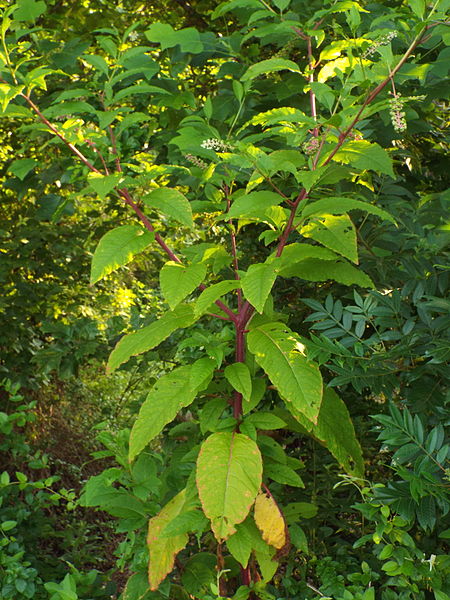
It has the look of a shrub, has red-purple thick stems, green lance-shaped leaves, and can grow up to 10 ft (3 m) in height.
Besides its red stems, other characteristics that make pokeweed stand out are its fruits. In late summer, it produces grape-like green berries that grow in clusters. When ripening during the fall, these get a dark-purple color.
Do not eat the fruits produced by pokeweed! They are poisonous to humans and most animals. Not only their fruits are toxic but all the parts of the plant are.
Pokeweed is a very adaptive plant that can grow in many soil types and environments, overwhelming native flora. That’s why in many regions, pokeweeds are considered invasive plants.
Several species of birds are immune to the toxins in the berries of this plant. They consume the fruits and thus, helping pokeweeds spread from one place to another.
2. The Castor Bean (Ricinus Communis)
The castor bean (Ricinus communis) is a fast-growing large flowering perennial shrub. It is also commonly known as the castor oil plant.
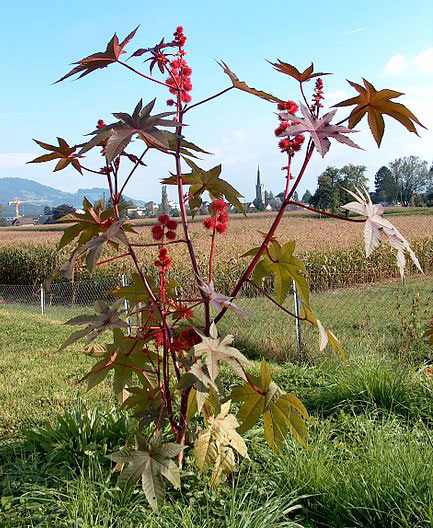
Ricinus is very easy to identify in its mature form. It has a small tree’s look and, in climates without frosty winters, can reach impressive sizes of up to 39 ft (12 m) in height.
It has large glossy palmated leaves supported by long reddish stems that connect to a main thick stalk and produces spiny green or red-purple fruits that encapsulate oval seeds, which resemble beans. Some varieties have green leaves and red stems; others are entirely purple-reddish or change their color as the plant gets older.
The castor bean seeds contain a highly toxic poison called ricin. It is believed that several seeds (when masticated) contain enough of this toxin to kill an adult man. This makes the castor bean one of the most poisonous plants on earth.
3. Pigweed (Amaranthus)
Pigweed (Amaranthus) is a genus of herbaceous plants that includes more than 70 species that grow in many countries. Almost all of them are edible and some are even grown as leaf vegetables, ornamental plants, or as an alternative to cereals.
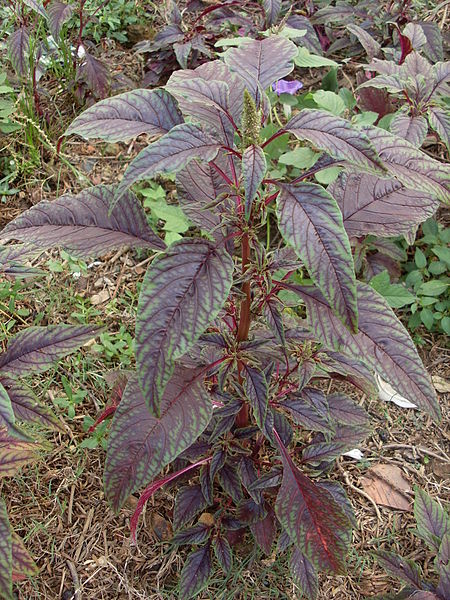
Amaranths are erect plants with broad leaves and with colors from green to purple and red. They produce flowers that are either green, white, red, red-brown, or orange-brown. The flowers of some varieties are utilized to produce a dye that is often used in the food industry but banned from the US due to some potential carcinogen risks.
Not all amaranth varieties have red stems, so this is not a defining feature for identifying these plants. Also, in some species, the stem can acquire a reddish color as the plant ages. The height of the plant also varies from one variety to another.
4. Himalayan Balsam (Impatiens Glandulifera)
Himalayan Balsam (Impatiens Glandulifera) is a fast-growing large annual plant indigenous to the Himalayas mountainous regions. It is also commonly known under many other names, including policeman’s helmet, ornamental jewelweed, bobby tops, kiss-me-on-the-mountain, copper tops, etc.
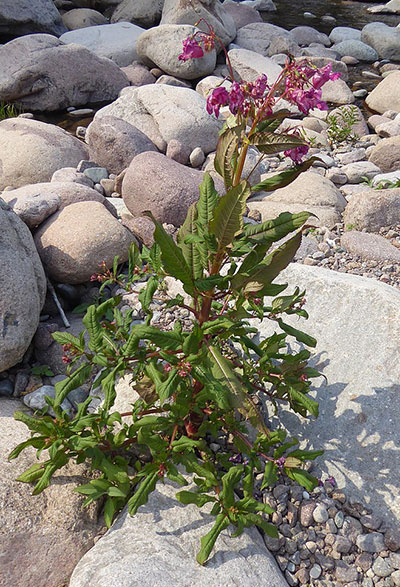
This plant grows upright and has a primary green or red stem that hardens when it reaches maturity. The leaves are green, have the shape of a lance, and ending with a pointy top. It produces blooms that are either white or pink and have a hooded shape. A plant can reach up to 6.5 ft (2 m) in height.
Due to human introduction to non-native areas, it is now found in many countries. In some, it is considered an invasive plant. It is highly adaptable and spreads quickly due to its efficient explosive seed dispersal mechanism, which propels the seeds at a great distance from the plant.
5. Wineberry (Rubus Phoenicolasius)
Wineberry (Rubus phoenicolasius) is a species of perennial plants native to several Asian countries and introduced in various regions of North America and Europe. Other common names include Japanese wineberry, dewberry, or wine raspberry.
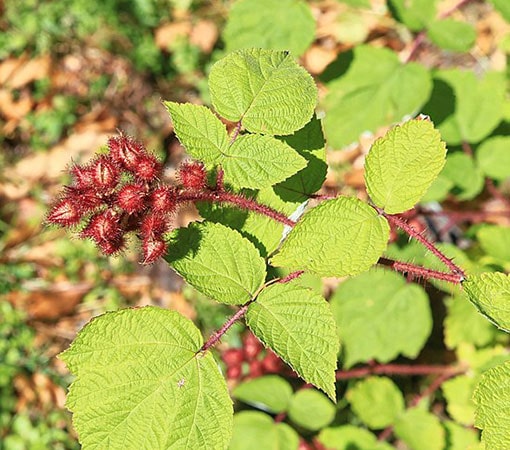
The plant has a main green or reddish stalk with side shoots that grow in the plant’s second year of life. The leaves are large, green on the top and silver at the bottom. The surface of stems and the beneath of leaves are covered in dense reddish hair and thin spines.
In summer or early fall, wineberries produce edible fruits that are about 1 cm in diameter. These initially have a green color, then turn red when ripening. Their taste is similar to the raspberries but a little bit tarter.
These berries develop in dense clumps and thrive in many wild regions, frequently growing on roadsides and at the edge of forests and fields. Their stalks can reach up to 10 ft (3 m) in length.
Because they multiply rapidly and due to their way of growing in dense bushes that can negatively affect the local flora and fauna, wineberries are considered invasive plants in many regions.
6. Red Osier Dogwood (Cornus Sericea)
Red osier dogwood (Cornus sericea) is a medium-sized shrub species in the family Cornaceae, which typically grows in wetland areas. It is also known under names like redstem dogwood, red willow, American dogwood, red-rood, western dogwood, and creek dogwood.
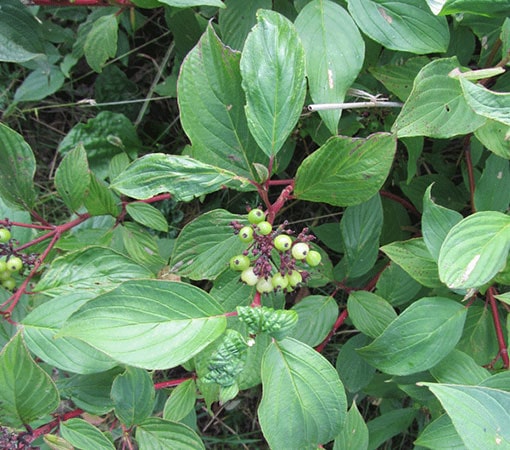
Cornus Sericea has elliptical green leaves, whose edges can sometimes take on a slightly reddish color. Its branches and twigs have normally a dark red color, but some plants may lack this coloration in shaded areas. It can reach up to 13 ft (4 m) in height and 16ft (5 m) wide.
Red osier dogwood is a common ornamental shrub mostly due to the red coloring of its twigs that stands out after it loses its leaves in the cold season.
7. Common Purslane (Portulaca Oleracea)
Common purslane (Portulaca oleracea) is a fast-growing herbaceous annual weed in the family Portulacaceae. It is distributed globally and has many other names, with the most common being common purslane, pursley, duckweed, wild portulaca, and little hogweed.
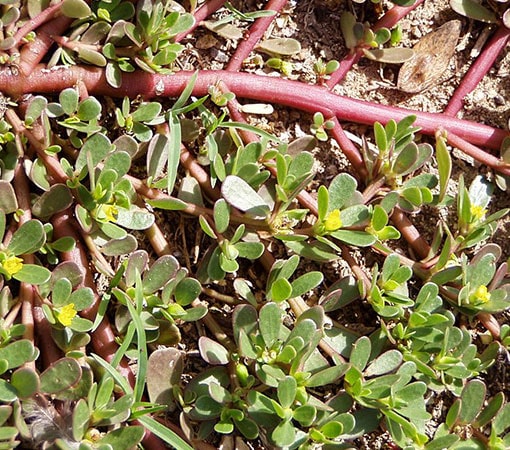
It is a trailing plant that spreads on the soil’s surface, has smooth succulent reddish stems and glossy leaves of a dark green color. Leaves are clustered at joints and stem ends. Throughout the year, it produces small yellow flowers that have heart-shaped petals. These are later replaced by seed capsules.
Common purslane is edible and has been eaten for hundreds of years by humans. Although in some places, it is considered a weed, in various regions, it is regarded more like a vegetable as many consume it raw or cooked.
8. Peonies (Paeonia Spp.)
Peonies (Paeonia spp.) is a genus of flowering herbaceous perennials and shrubs indigenous to Asia, Europe, and Western North America.
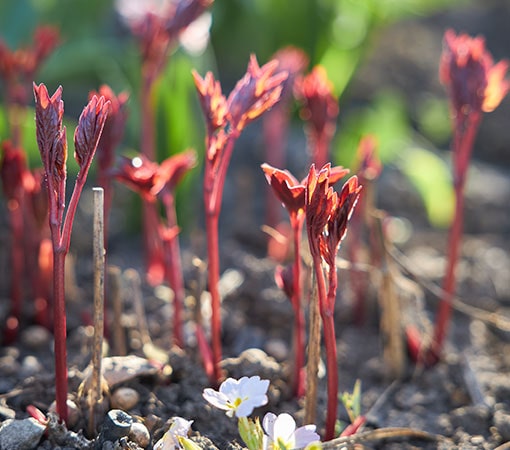
Peonies are popular garden plants because they require almost no care, have a long lifespan, and produce beautiful flowers of various colors. Although there are more than 30 species of peonies, the most common is the garden peony (common peony).
Peonies are easily recognizable when the plants are in bloom and when their foliage is fully formed. Many have trouble classifying them when their sprouts emerge in clusters from the ground during spring. In this growth stage, the shoots have a pretty alien look, and both the stems and the leaves can have a reddish color, making peony’s identification pretty difficult for someone who has never seen this plant in this early development phase.
As the plant grows, the leaves and stems usually turn green. However, there are also some species, such as the Balearic peony (Paeonia cambessedesii), whose stems and under leaves remain red even when the plant reaches its maturity.
9. Elephant Bush (Portulacaria Afra)
Elephant Bush (Portulacaria afra) is a semi-evergreen succulent shrub indigenous to South Africa. It is also known as dwarf jade plant, porkbush, or spekboom.
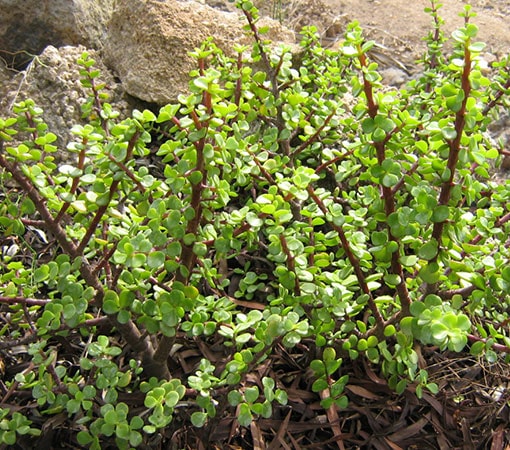
It grows wildly in the East of South Africa, is used as a landscape plant in several regions of the US and as an ornamental plant in many parts of the world. Elephant bush is also often grown as bonsai.
Portulacaria afra has succulent glossy green leaves and red stems, which thicken and turn reddish-brown as the plant ages. An adult shrub can reach more than 13 ft (4 m) in height.
During the plant’s early stages, the elephant’s bush leaves and stems look like the ones of common purslane (Portulaca oleracea). It can also easily get confused with Crassula ovata (the jade plant) when grown as a bonsai.
10. Mountain Pepper (Drimys Lanceolata)
Mountain Pepper (Drimys lanceolata) is a type of shrub native to Australia. Other popular names of this plant are Tasmanian pepperberry and Cornish pepper leaf.

This shrub has red stems with dark green long leaves, which are broader in the middle, and have the shape of a lance tip. It produces white or cream flowers in the summertime, which during the fall turn into two-lobed dark-colored berries.
The leaves and fruits of this plant have a pungent aroma and are often used as a substitute of black pepper, hence the popular name of the plant “mountain pepper.”
Final Word
This is just a small part of the multitude of plants that have a red stem. I hope you found this article interesting and helpful.
If your goal is to find out the name of a plant, I recommend seeing our guide on identifying plants with mobile apps. These can help you recognize a plant much faster and effortlessly by simply taking a picture of an unknown plant’s leaves, flowers, or fruits. You can even identify species of trees just by taking a photo of their bark.

